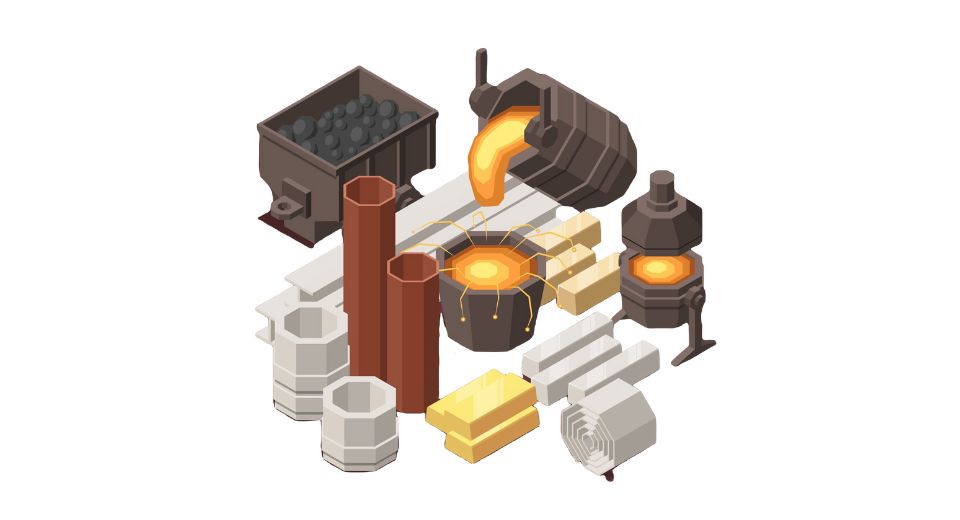
Nov 15, 2024

The global Ferroalloys Market is used in many different industries; hence, it is an important thing for the steel production process, manufacturing, and construction of infrastructures. Ferroalloys are iron-based alloys prepared with additions of elements like manganese, silicon, chromium, and vanadium, which can make the properties of the steel better by giving it hardness and durability together with resisting corrosion. This market has witnessed an upward trend in the last few years with the rising demand for superior quality steel and other complex alloy types across different industries.
Steel is essentially the lifeblood of the global economy as much of its construction is put into buildings, bridges, automobiles, and heavy machinery. Ferroalloys contribute toward the production of steel through increasing overall quality and performance. For example, high manganese ferroalloy can be used in steel with the aim of increasing the resistance to wear and tear, while silicon ferroalloy aids the production of higher strength steel. The growing construction and automobile industries in these economies boost the demand for quality steel and, subsequently, ferroalloys, which furthers the market.
Industrialization in developing economies has also helped boost the Global Ferroalloys Market. China, India, and Brazil have been among the fastest-growing economies in the world, rapidly urbanizing and developing their infrastructures; hence the level of ferroalloys used in the production of steel and other alloy components is higher. In China, for instance, the market is booming because of the country's supremacy in steel production, besides the government efforts to reform the manufacturing and infrastructure capabilities of that country. This trend is visible not just in Asia and Latin America but across the globe as industrial output and construction-related activities keep growing with demand for ferroalloys.
The other major defining trend in the Global Ferroalloys Market is increasing sustainability. Rising environmental concerns across the globe have led to a concerted push toward reducing the carbon footprint of industrial processes. Steel makes up the most demanding user of ferroalloys, while the manufacture of steel is an energy-intensive process with a high carbon dioxide emission profile. It is therefore in the interest of the business to attempt to reduce emissions and to make the production process greener and more efficient. This has driven innovation in the establishment of greener alternatives based on ferroalloys produced by more energy-efficient means or from recycled materials. The new and innovative forms of alloys shape the future of the market, with an industry trying to meet the demand for high-quality alloys and the increasing demand for sustainability.
Technological advancements fuel the growth of the Global Ferroalloys Market. Over time, production techniques have evolved to produce alloys that exhibit superior properties-superior tensile strength and improved resistance to heat and corrosion. These new developments have been behind new applications of ferroalloys in the aerospace, auto, electronics, and other industries. For example, stainless steel has largely been produced with the inclusion of ferrochromium due to the fact that this type of alloy enhances corrosion resistance, a very important parameter for many high-performance applications.
The market is never without its challenges. Raw material price volatility is one of the prime risks associated with ferroalloys since it is a product produced from raw materials varying from metals such as manganese and chromium to silicon. The prices fluctuate sideways due to reasons such as geopolitical tensions or supply chain being disrupted, among others. These volatility issues affect the profitability of firms in the ferroalloys industry and therefore contribute to market volatility. Furthermore, mining and manufacturing activities significantly impact the environment. The series of clearing and pollution of water bodies complicate further the running of the industry. Business then have to find a balance between the need to become profitable and the imperative of minimizing their environmental footprint.
Regulatory and governmental policies form a significant portion of the Global Ferroalloys Market. Governments around the world have framed several regulations with the objective of reducing industrial emissions and making the manufacturing process more environment-friendly. In this context, the way ferroalloys are being produced and priced is very likely to change since now companies have a stricter environmental standard to adhere to. Trade policies, tariffs, and international regulations will also impact the movement of ferroalloys around the world. It impacts the both supply and demand sides.
With increasing demand for ferroalloys in the coming years, it is expected that the ferroalloys industry market will increasingly become a competitive market. Some of the top players are long-spanned multinational enterprises with huge operations in mining, production, and distribution businesses. Therefore, they widely invest in research and development of new production techniques that can save them more and create quality output. Other players, especially in the smaller regional markets, make their contributions through niche products, such as specialty ferroalloys for niche applications. This brings to the market a diverse and highly competitive scenario.
The future of the Global Ferroalloy Market looks bright as growth is anticipated in all regions. With advancing technology in the development of new alloys with superior properties and sustainability becoming increasingly important for industries in nearly all parts of the world, the scope for innovation and growth in the market is immense. The demand for high-quality steel along with industrialization in many emerging economies and calls for sustainable production methods continues to propel the growth of the ferroalloys sector.
In a nutshell, the Global Ferroalloys Market is part and parcel of the expansion of industries that operate using steel and other advanced materials. Even though the raw material price volatility, environmental concerns, and regulatory pressure persist, the reasons driving the future of the market lie in technology enhancement, sustainability measures, and rising demand for high-quality alloys. This ongoing market expansion for ferroalloys will certainly leave a long-term impression on the global economy, forming industries as wide as construction to aerospace.
Drop us an email at:
Call us on:
+1 214 613 5758
+91 73850 57479